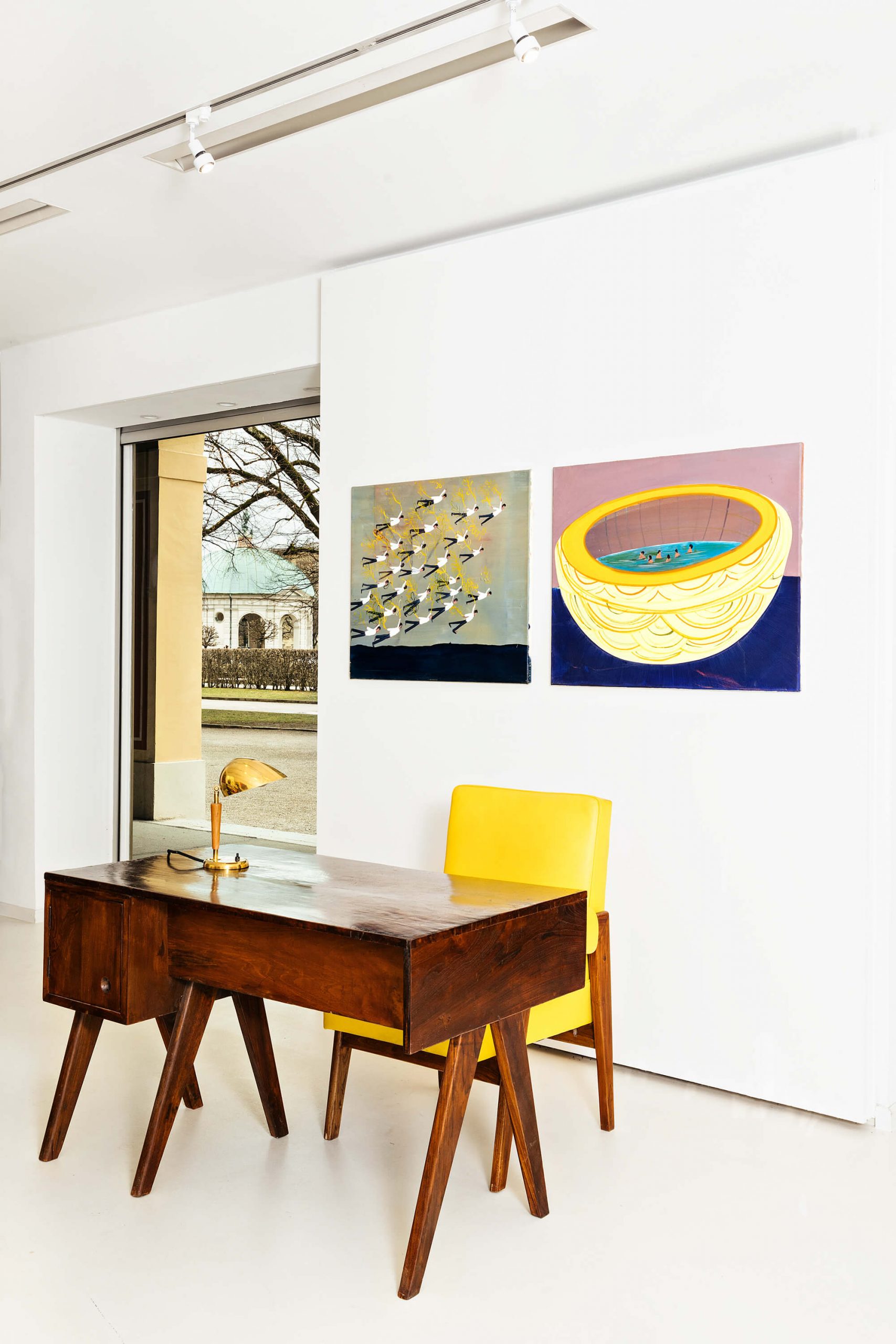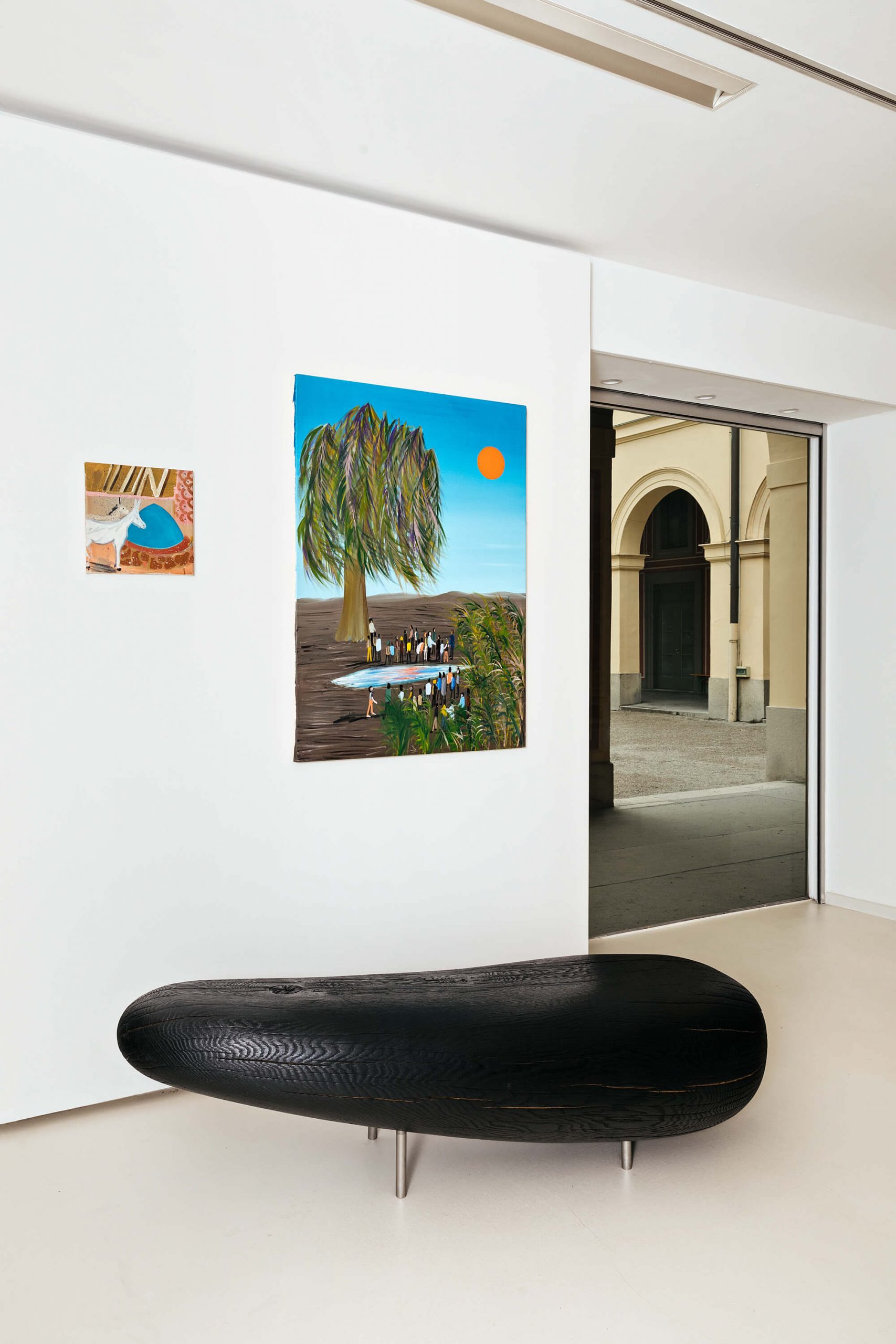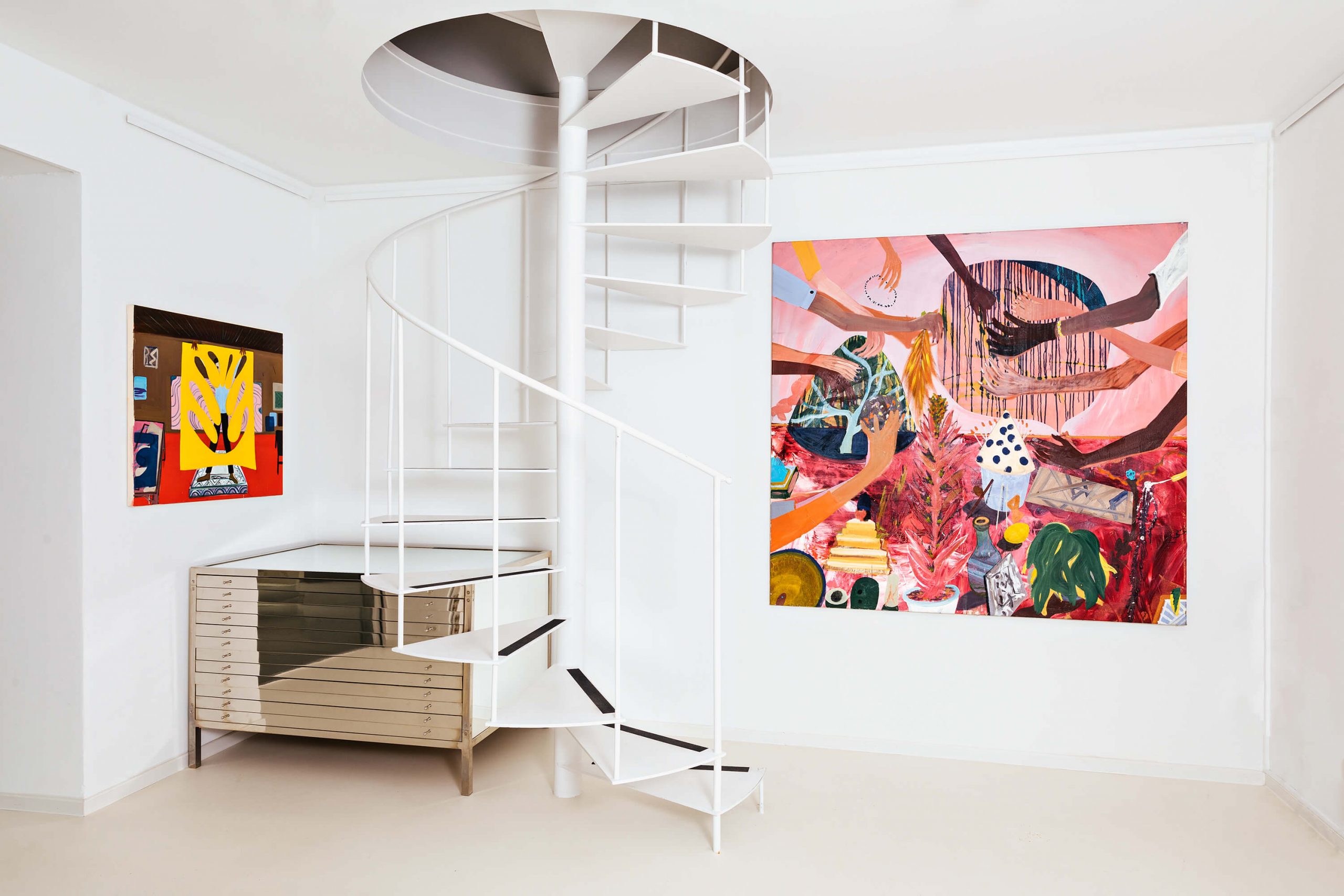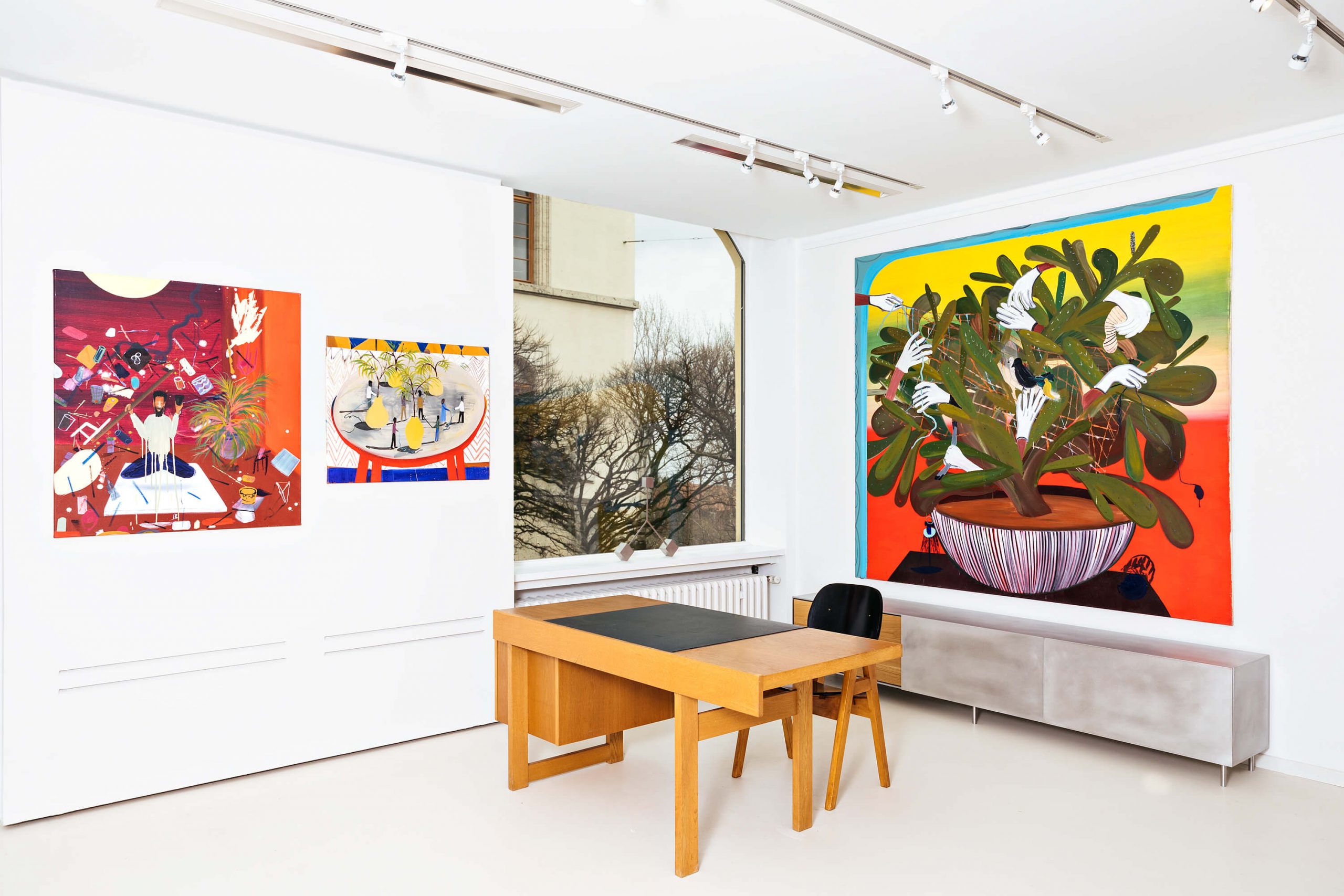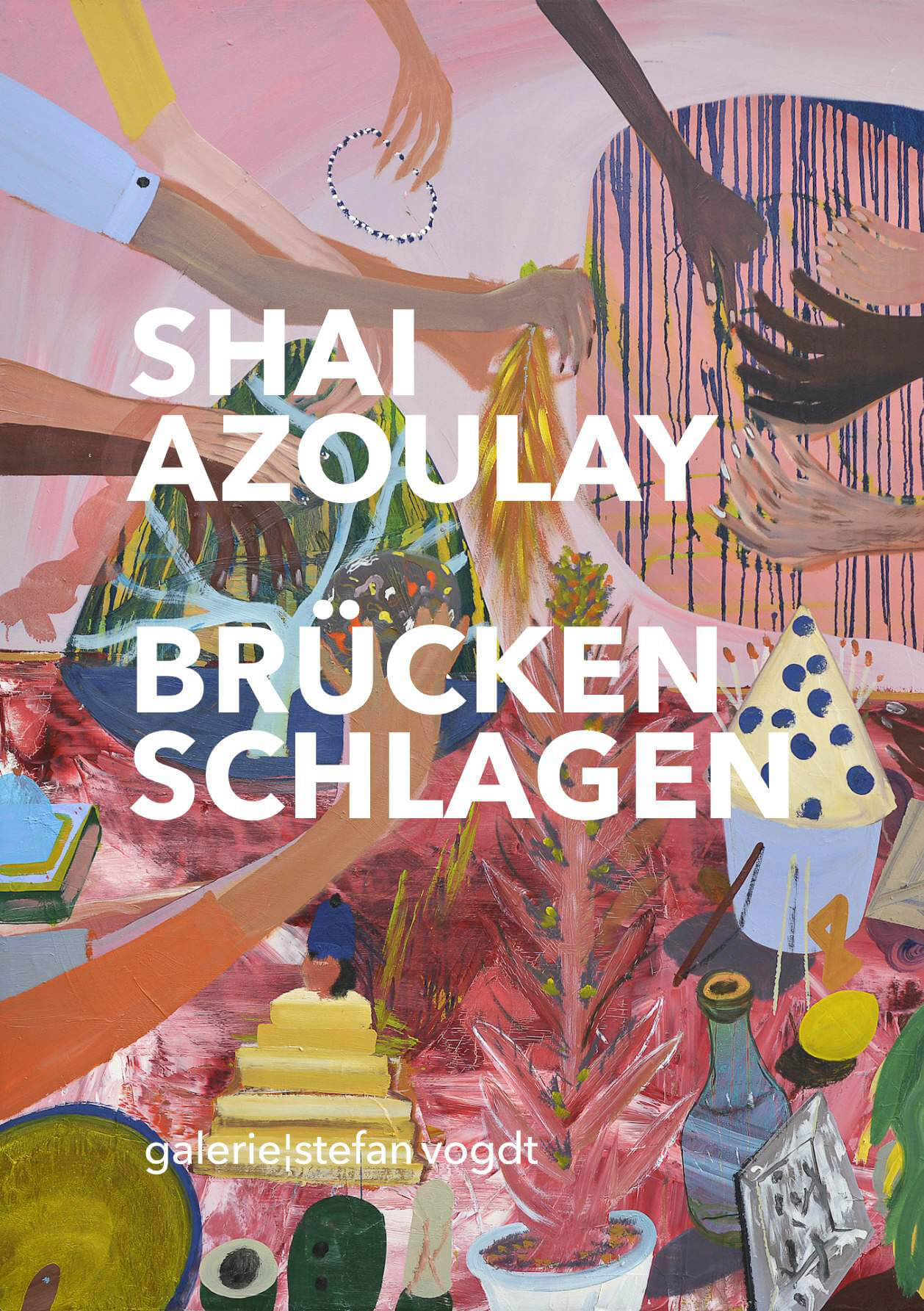Essay by: Tinatin Ghughunishvili-Brueck
The painting “Tantra Painter” (Fig.1) by Shai Azoulay is one of his most characteristic works and at the same time one of the most unusual paintings for an artist in his studio.
Compared to many of his colleagues in the present and the past, who often present themselves as melancholic “pain men” or at least as contemporaries not necessarily facing the sunny side of life, Azoulay shows us a completely different image of himself.
In front of a deep red background, the artist floats cross-legged above a white canvas. His schematically painted face expresses contentment. In his hand he holds a stick as a sign of balance. His white blouse melts like ice cream under the glaring sun. The drops of paint seek their way to the canvas. The artist becomes one with his painting, with his actions, with his surroundings. Not only he but all objects in the room fly around weightlessly. As ideas that are about to find their place on the canvas?
This lightness, situational comedy and humorous self-reflection can be found in many of the artist’s studio paintings. He often paints himself hanging in the air in a trance-like state over a still blank canvas. In the work with the ironic title “Holy me” (fig.2), a female art critic is presumably shown in the studio painting. She has taken a seat at the desk opposite the artist and is writing about him. The artist, in turn, is floating in the air, connected by invisible threads to his painting spread out on the floor. With every word of praise and criticism, she could decide on the artist’s fall or suspension, at least that is what this constellation, well known in the art scene and presented with a wink, suggests. As on a theater stage, the “magical spectacle” is observed by the audience, which has taken a seat on the steps in the background of the picture.
As so often, Azoulay creates the framework of his composition with strong, warm colors and with the recognizable, but not dominant structure of the material. The brushstroke is mainly subordinate to the composition of the picture. The choice of colors and patterns, the spontaneity of the lines, and especially the weightless human figures create an atmosphere of serenity.
The human silhouettes are often depicted without identifiable faces. Against a vibrating background, they intertwine like ornaments of a carpet. They are recognizable as a community and individually not replaceable.
This way of depiction results from an intention. One of the main themes in the work of Shai Azoulay is the importance of a community for the individual and the role of the individual in a collective. In his paintings he explores this role in the society of his homeland and in the Jewish Orthodox community to which he belongs.
A vivid example of this can be found in the work “Flaying moment” (fig. 3).
The picture shows a group of men dressed in white flying horizontally into the picture from the left. The movements are synchronous and resemble a ritual dance. In uplifted hands they hold green branches, which at the same time seem to free them from the attraction of the black painted ground. The iconography of this painting recalls the symbolism of the Jewish feast of Sukkot. The traditionally tied palm branch, the so-called lulav, is held in the hands of the men of the community dressed in white prayer shawls during the celebration.
In addition to the artistic examination of the customs of Judaism, Azoulay also seems to be interested in the visual-aesthetic aspect of community, mystical rituals, their forms, colors and gestures.
In this respect, there is a reference to the French-Russian artist Marc Chagall, who dealt with his Jewish heritage and yet, without any isms, invented his own modern pictorial language.
Therefore, compositional allusions to Chagall’s pictorial vocabulary, such as the floating figures, for example, or the symbolic use of colors, can be assumed in Azoulay’s work.
He is well versed in art history and confidently and inventively stages his references in his own works. As well as the art of the important French painter Henri Matisse. Matisse’s so-called cut-outs, the intense colorful paper cuts that the artist created in his late phase play an important role in Azoulay’s compositions. In the work “Time out” (fig.4) a male figure holds a yellow leaf-shaped silhouette a la Matisse in front of him. It mostly veils the figure and dominates the room in which the action takes place. In the background we see suggested artworks on the walls, with patterns here and there. The carpet in the center of the composition is rich in color and features oriental-like ornaments. With this figure in the painting, standing on the traditional carpet, Azoulay shows a kind of extended self-portrait of the artist. Despite his reference – interests to the well-known figures of the Western canon, he also draws from the breeding grounds of his cultural identity.
For Azoulay, however, the roots of his art lie not only in his multicultural identity and habitat, but also in the pure and playful world of childhood. “It’s always moving to see children putting lines and dots together and depicting large worlds in a single naïve moment,” he writes. Authenticity and the act of creating that arises from the subconscious is why painting, often thought dead, has overcome all crises, Azoulay says.
With this position, Azoulay takes on the legacy of the Neo-Expressionists and the so-called “Bad Painting” movement.
Figurative, narrative, expressive, raw, light, and difficult to classify were the works of those artists who, since the early 1970s, questioned the prevailing styles and the purely intellectual approach to art (such as conceptual art or minimalism). This almost instinctive, uncontrolled and profoundly individualistic mode of formal artistic expression became the distinguishing feature of artists such as Jean-Michel Basquiat, Julian Schnabel, Miriam Kahn and many others.
For all their freedom of expression, however, it is important not to forget that all of these artists pursued decidedly substantive goals and addressed important aspects of their present. Shai Azoulay is no different. Through his decidedly positive and constructive worldview and through the universal language of his art, Shai Azoulay manages to build bridges where they seem to be nonexistent. For this achievement, the Jerusalem-based artist was honored last year with the prestigious Landau Prize of the State of Israel.
Already his biography can be read as a metaphor of overcoming any borders and prejudices. The child of immigrants from Morocco and Spain, he grew up in a border town with Lebanon, in a multicultural and largely secular environment. Azoulay now lives and works in Jerusalem as a practicing Orthodox and professional artist.
His hunger for painting brought him to art school after 3 years of military service. He received his Master of Fine Arts degree from the Bezalel Academy of Art and Design in Jerusalem.
In 2011, Azoulay had his first major museum exhibition at the Tel-Aviv Museum of Art and 2018 a major solo exhibition at the Herzliya Museum of Contemporary Art.
His works were shown in solo exhibitions in New York, London, Tokyo, Vienna, Chicago and Beijing.
Munich, February 2021

